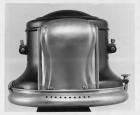|
Re: '49 instrument panel lights question.
|
||||
|---|---|---|---|---|
|
Home away from home
|
Regular incandescent bulbs shine through a filter which produces the black light.
Posted on: 2015/7/30 20:55
|
|||
|
||||
|
Re: '49 instrument panel lights question.
|
||||
|---|---|---|---|---|
|
Forum Ambassador
|
The bulbs are covered by a UV filter which is the dark lens you were seeing. The actual illumination provided by the bulbs thru the filters is a very deep and almost nothing being visible purple light and in of itself is not of much use. You can see a tiny bit of light at the bulb locations if the surrounding area around the car is dark. The paint on the numerals and needles on the actual instrument is a white but luminescent paint which is energized by the UV. As you can see from the photo in the owners manual only those painted parts show at night and are a glowing green color when active.
If yours isn't working quite like the manual says, after 65 years the paint has probably lost most of its strength and in some cases has flaked and fallen off. There have been a few who have managed to use a modern luminescent paint to redo the instruments but it is a tedious undertaking. There have been others who have elected to remove the UV lens filters so the bulb illuminates in the normal fashion. While that approach works it does eliminate one of the unique features that Packard and other cars of that era were doing to add some pizazz. Attach file:  (33.37 KB) (33.37 KB)
Posted on: 2015/7/30 20:58
|
|||
|
Howard
|
||||
|
||||
|
Re: '49 instrument panel lights question.
|
||||
|---|---|---|---|---|
|
Home away from home
|
That's neat, I didn't know about that feature on those cars. My high-tech, space age 1956 Cessna 172 four place airplane also has luminous instruments, that work with normal light (it uses red spotlites to illuminate the panel). Trouble is, you cannot get those instruments rebuilt as the EPA or somebody has determined that the radium paint used is hazardous (radiation) so nobody will touch them. After all these years it barely works anyway, I can shine a flashlight at a gauge and it will glow brightly for about 5 seconds after.
Posted on: 2015/7/30 22:06
|
|||
|
1952 Model 200 Deluxe Touring Sedan
HA's 52 Grey Ghost "The problem with quotes on the internet is you never know if they're true" - Abraham Lincoln |
||||
|
||||
|
Re: '49 instrument panel lights question.
|
||||
|---|---|---|---|---|
|
Quite a regular
|
Thank you for the info! I actually have two complete instrument clusters. On the one for my car, the paint luminous paint is coming off, but the spare unit is still in pretty good shape. I may try experimenting on the worse of the two. Thanks again!!
Kevin
Posted on: 2015/7/30 22:16
|
|||
|
||||
|
Re: '49 instrument panel lights question.
|
||||
|---|---|---|---|---|
|
Home away from home

|
Quote:
They aren't at all dangerous to be around. Radium is primarily an alpha emitter, which even a sheet of paper or your skin will block. It's only hazardous to ingest (or inhale). It's the people that painted the instruments by hand that were thus exposed so the paint is no longer made to protect workers. There are alternative luminous pigment paints that glow under UV exposure but they degrade relatively rapidly. What is noteworthy is that the dimming of radium dials over time is not due to the decay of the radium, which has a half-life of around 1600 years. It's due to the degradation of the phosphors that the radium excites. If the paint is still intact and not flaking off, recoating with a very thin layer of the phosphors will restore luminosity for some time.
Posted on: 2015/8/2 23:16
|
|||
|
1942 Clipper Club Sedan
1948 Custom Touring Sedan (22nd Series) 1955 Patrician Sedan 1955 Four Hundred Hardtop Coupe |
||||
|
||||








